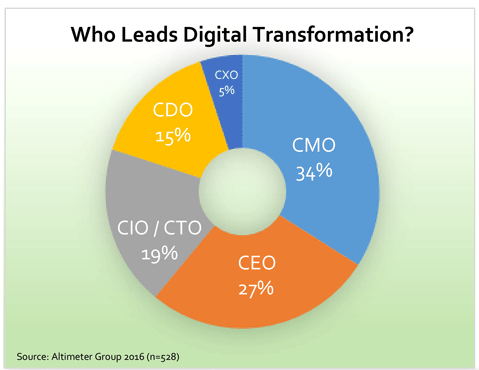Research from Altimeter Group suggests that Chief Marketing Officers (CMOs) are far more likely to lead digital transformation within their organisations than their IT Officer (CIO) colleagues.
The spin on CIO.com is that this is because “CIOs agendas are already full”, which I guess means that CMOs are off chasing butterflies.
To be fair, the writer also quotes analyst Brian Solis acknowledging that while CIOs tend to be tied down dealing with heritage infrastructure issues; CMOs “live and die by how successful they are in reaching new customers, driving sales and conversions.”
My own experience of working with senior IT and digital specialists is that they are very open to change. However, with a department swamped by day-to-day issues of hardware, software and user-generated faults; upgrading to the latest version of SAP (and back again); approving new vendors; and keeping the system safe from Virus attack and Power-cuts: the challenge of a transformation project is daunting.
Being deliberately over-simplistic, the difference between the roles of CIO and CMO are their perspectives – Internal versus External perspective.
The CMO has to balance the speed-of-change in customer and consumer expectations, with the need to drive measurable growth in the business. The “digital revolution” around marketing communications means that many businesses see “Digital Marketing”, measured by CPC and “Last click attribution ” as the way forward. A good CMO recognises that “Digital” is just one of the tools in the great marketing tool-box .
The world has moved on from companies deciding they need to develop “a digital strategy”, to a recognition that “digital” has to be integrated into every nook and cranny of the business, from production and distribution, finance and HR, and (in this ever-more-connected world) to customer and consumer relationship management.
McKinsey* analysis in 2015 identified that 90 percent of top performers have fully integrated digital initiatives into their strategic-planning process.
.. and that’s the nub… We shouldn’t be aiming to “become successful Digital Businesses”, but instead be “successful businesses in a Digital age”
In the final analysis, the answer is not who takes the lead, but how we all work together …
———————————————————-
Chris Collis is Director of Marketing Walk, an independent Marketing and Business Strategy house.
———————————————————-
*link to mckinsey.com/…/the-new-chief-digital-officer

